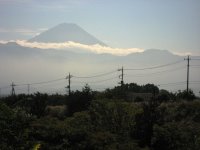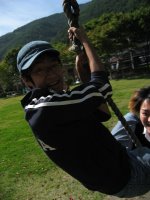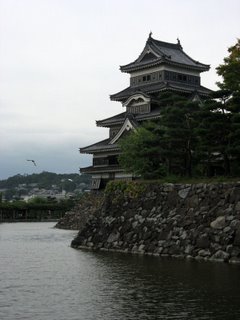 Another early rise, but I was quite punctual today. We were due to meet at 8am at Shinjuku station; a recipe for disaster, mainly because it’s just so easy to get lost in Shinjuku station. I met up with Reed at the rotary at 7:30. He had been there since 7, and only Willy had shown up, and was now missing again. At about quarter to 8 we decided that we waited as long as we could, and started to make our way to the station. As we crossed the street, we ran right into a large group of students, including the ones that we had been missing, led by Dr. Shek. Relieved, we went to Shinjuku and met up with everyone. Without much further ado, we jumped on the bus and got out of town.
Another early rise, but I was quite punctual today. We were due to meet at 8am at Shinjuku station; a recipe for disaster, mainly because it’s just so easy to get lost in Shinjuku station. I met up with Reed at the rotary at 7:30. He had been there since 7, and only Willy had shown up, and was now missing again. At about quarter to 8 we decided that we waited as long as we could, and started to make our way to the station. As we crossed the street, we ran right into a large group of students, including the ones that we had been missing, led by Dr. Shek. Relieved, we went to Shinjuku and met up with everyone. Without much further ado, we jumped on the bus and got out of town. The ride there was quite enjoyable. The people in my immediate area played a lot of word games and stuff to keep things interesting. After stopping for a bite to eat and a view of
 We stopped at a small village called “Narai” for a couple hours to poke around a bit. Apparently, Narai is one of the few remaining pit-stops on the old feudal era roads that the Daimyo (lords) took every other year to pay homage to the shogun (head honcho) in
We stopped at a small village called “Narai” for a couple hours to poke around a bit. Apparently, Narai is one of the few remaining pit-stops on the old feudal era roads that the Daimyo (lords) took every other year to pay homage to the shogun (head honcho) in  We then made our way over to an amazing wooden bridge overlooking a small river. I sat under the bridge and admired the shade, breeze, and scenery my vantage point provided. Some of the students ventured down to the stream, and a couple brave Japanese students took off their shoes and waded into the cold water. Hans sat nearby under the bridge, but when he went to stand up, struck his head on the underside of the bridge hard enough to draw blood. His wounds weren’t fatal, so we all started to head back to the bus.
We then made our way over to an amazing wooden bridge overlooking a small river. I sat under the bridge and admired the shade, breeze, and scenery my vantage point provided. Some of the students ventured down to the stream, and a couple brave Japanese students took off their shoes and waded into the cold water. Hans sat nearby under the bridge, but when he went to stand up, struck his head on the underside of the bridge hard enough to draw blood. His wounds weren’t fatal, so we all started to head back to the bus.
The rest of the trip was relatively uneventful. More jokes and gossip and reading and sleeping were the staple of the day. We made one more quick stop at a shop that sold urushi (lacquerware) goods. I didn’t buy anything, but in retrospect I probably should have; urushi that particular area’s specialty.
 We finally arrived at Matsumoto about an hour later, and spent maybe an hour or so exploring the castle and the castle grounds. Of all the castles in
We finally arrived at Matsumoto about an hour later, and spent maybe an hour or so exploring the castle and the castle grounds. Of all the castles in
Back to the bus, we all went. The ride back was decidedly more subdued. An enormous nomikai was planned for that evening, and we were running behind schedule. Alas, we would be at least an hour late for the event, and so we had to make our own plans. To be honest, by the time we all got back to ‘baba, I didn’t feel much like drinking, but a few other Japanese students showed up and cajoled me into going to a smaller nomikai with some of the other CSU students. Teru had made a reservation at the fire-hazard place, called Han-Zou. The drinks are watered down and the food isn’t that good, but it was the cheapest venue and only place we could find at such short notice. Some of the people, upon seeing where we were headed, decided to dotakyan (flake) and took off. We didn’t go crazy or anything, but we had enough fun to warrant the expense (teaching random hand gestures to the Japanese students). By now, I think I’m ready for a couple liquor-free weeks.
 We returned to ‘baba and found a sizable group of students from the big nomikai still gathered. A group was being organized to go to the Hub for a nightcap, including some people I knew, so I figured I’d go along as well. I didn’t order anything at the hub, having already spent plenty that evening, but I enjoyed some interesting company. I met a couple of the Italian students and a Japanese-Chinese girl from
We returned to ‘baba and found a sizable group of students from the big nomikai still gathered. A group was being organized to go to the Hub for a nightcap, including some people I knew, so I figured I’d go along as well. I didn’t order anything at the hub, having already spent plenty that evening, but I enjoyed some interesting company. I met a couple of the Italian students and a Japanese-Chinese girl from
One surprising thing about
1 comment:
I like your insite on the "European kiss" for the Japanese women. Talk about just a horrible idea for an excuse to get near women in Japan. I knew numerous people from Europe during my stay, and most were some of the better study abroad students at Waseda. They knew enough not to do something that stupid.
When abroad, don't impose or use your own culture as an excuse to get your way if you know it will make people uncomfortable. You are a guest in "their house." Luckily, you already know this. Unfortunately, you are around people are f@$king idiots and don't give a damn.
Maybe they will learn later.
Post a Comment